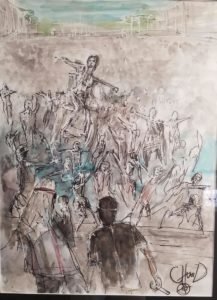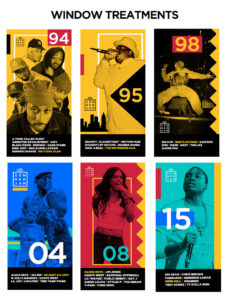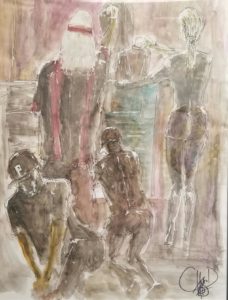The definitive history of hip-hop doesn’t lie in the Bronx—at least not yet. For now, it’s sitting in rows of boxes inside a fine art storage facility in Newark, N.J.
That’s where the principal archive for the Bronx’s soon-to-come Universal Hip-Hop Museum is being stored until construction is finished on the project’s nearly 60,000 square-foot facility just north of the 145th Street Bridge. With a core formed from the vast collection of hip-hop legend and historian Claude “Paradise” Gray, it’s likely already the largest stockpile of hip-hop memorabilia in existence and is only growing as the museum’s 2022 opening date approaches.
Open up one box and you might find a collection of cassettes, vast in scope but full of many difficult-to-find gems like Cool C’s I Gotta Habit and Steady B’s Let the Hustlers Play—tapes that vaulted both Philadelphia natives to local celebrity before it all came crashing down in a botched 1996 bank robbery attempt.
Open up another and you might stumble upon several original pieces of artwork courtesy of Chuck D, the firebrand frontman of socially conscious rap group Public Enemy. Concert scenes show rough-hewn outlines of a crowd, while several performers look on, hands raised in defiance. “Prophets of Rage,” one is titled. “Backed by the God of Hard Drums,” another reads.
“People understand that these artifacts will outlive us,” said Gray, the museum’s chief curator and former member of pioneering hip-hop group X-Clan. “It’s only right that they reside in the Bronx and are no longer stored in people’s basements. These things are asking to be on display and accessible to everyone.”
The Paradise Collection is a thing 2 behold. The Chief Curator of the Universal Hip Hop Museum, Paradise Gray, has had the vision 4 preserving Hip Hop history 4 many years. We R thankful 4 this! #MuchRespect #HipHop #HipHopHistory #UHHM #UniversalHipHopMuseum #XClan @ParadiseGray pic.twitter.com/234fxmXNLM
— UHHM (@uhhmuseum) September 4, 2018
The collection tracks the history of hip-hop, starting in the basement of an unassuming south Bronx apartment building where DJ Kool Herc first used two turntables to extend a song’s drum beat—the “beatbreak”—by switching from one record to another. From there, it aims to tell the story of the genre’s rapid growth and cultural impact—showcasing things like graffiti, sneaker culture, dance, urban fashion and other movements that can trace their history back to hip-hop. With a definite nod to the genre’s global reach today, collectors hope to acquire everything from records to photographs, CDs, clothes, videos, cassettes, artwork, magazines, posters, writings, ticket stubs and much more.
The ambitious project is the result of nearly five years of work on the part of Gray and a team of hip-hop enthusiasts and all-stars that includes pioneers Ice-T, Kurtis Blow, Shawn LG Thomas and Executive Director Rocky Bucano, who knew Gray and convinced him to participate in the project early on.
Several similar museum proposals have moved forward in fits and starts over the past decade, most notably a rival organization named the “Hip Hop Hall of Fame Museum” that’s currently fundraising in an attempt to break ground on a site in Harlem over the next few years. This history of uncertainty has presented practical challenges in gaining popular support and a fundraising base this time around, but after the Universal Hip-Hop Museum gained City Council approval last October for a new construction site just south of Yankee Stadium and secured $20 million in city and state money, organizers say the future of the project looks bright.
“I think everyone’s initial response is, ‘There’s not a hip-hop museum already? How can that be?’” said Adam Silverstein, the museum’s director of archives and a board member on the project. “Our challenge right now is doing a better job at getting the word out, and that’s exactly what we’re trying to do.”
Central to that mission are Gray and Silverstein, who both plan to showcase their personal collections at the Universal Hip-Hop Museum. It was a no-brainer for Gray, who said he’s been a collector since well before he discovered hip-hop.
While he was growing up in the Bronx, Gray’s brother had stamps and coins, while he amassed a large stockpile of baseball cards. From there they both turned to comic books—but Gray, more than anything, wanted to find his own path.
“I rebelled against my brother, and old school hip-hop flyers fit the bill perfectly,” he said. “They had extremely comic book graphic styles, and the names of the hip-hop stars on the flyers were just like superheroes: Grandmaster Flash, Kool Herc and the Herculords, Grand Wizard Theodore.”
It was the early 1970s, and the south Bronx was coming alive with the sound of hip-hop. Gray lived in Soundview’s Bronxdale Projects—today rebranded as the Justice Sonia Sotomayor Houses and Community Center—one floor down from one of the genre’s architects, Disco King Mario.
The building’s laundry room, rendered mostly useless by people who had broken the machines to steal the quarters inside, instead became a laboratory in which to test the original formula of hip-hop. Though 1520 Sedgwick Ave. is commonly credited as the genre’s birthplace, Gray said, 1715 Bruckner Blvd. was more like the site of its first steps. The building saw a revolving door of artists like Mario and his protégé Afrika Bambaataa, as well as others involved in the Black Spades, a Bronx-based street gang that was influential in early hip-hop culture.
“One day I was walking by and I saw the door was cracked open so I peeked inside, and there he was: Disco King Mario,” Gray said. “I was absolutely amazed to see someone DJ-ing with two turntables … I was hooked from that moment forward.”
As he developed into an artist in his own right, it became increasingly easy for Gray to ask his friends and peers to pass along their items. Every new tour, every magazine cover, every new fashion hip-hop was championing at the time became a part of what would later become known as the “The Paradise Collection.”
“After a while I got to know the artists and the people whose stuff I was collecting,” he said. “I was hip-hop’s greatest fan, and a participant in it at the same time.”
The most cherished items in his collection, however, are the ones that trace Gray’s time in X-Clan: beads, jewelry, his signature hand-carved wooden walking stick and a crown he used to perform in that signifies the group’s membership in the Blackwatch Movement, a socially conscious strand of black nationalism that promoted revitalization of inner cities and community development through hip-hop.
Developing and showcasing a large archive of historical items, however, is as much a logistical challenge as it is an academic one. Recruiting donors with tax incentives requires the organization to register as a nonprofit, for example, and without a location to store items there were, for a time, physical constraints on how large the collection could become.
Paperwork, manual labor, communicating with bureaucrats and stakeholders, all of this takes time and money—two things that are currently at a premium for the Universal Hip-Hop Museum, which is operating as a 100 percent volunteer organization.
Enter Adam Silverstein. A lawyer by trade, he first came on board after agreeing to donate his collection of memorabilia and ultimately found himself reviewing legal documents and building up the nonprofit’s corporate infrastructure.
“I had to ask myself, ‘Who was going to build this?’” Silverstein said. “Well, the answer was that not many people were.”

Original Artwork by Chuck D: “Backed by the God of Hard Drums, Bard Wilke.” Watercolor, ink: 24 x 18 in.

Original Artwork by Public Enemy’s Chuck D: “Prophets of Rage: France July 2017.” Watercolor, ink: 24 x 18 in.
By handling the business operations and marketing of the museum, Silverstein’s plan was to allow Gray to focus on his artistic vision. In addition to his legal duties, about two years ago Silverstein began building a following for the Universal Hip-Hop Museum online using social media, curating playlists under the museum’s name, issuing press releases and revamping the organization’s website. All of this proved critical later on while fundraising and undergoing the political process of gaining approval from the city for a site.
With the hard part done, he says, the museum can now focus on the work of building a unique collection that spans nearly 50 years of history and will encompass hip-hop’s now global reach.
“I have no doubt that it will be the biggest and best collection of hip-hop music and culture in the entire world,” Gray said. “And we do have a focus on curating from the entire world.”

Bumpboxx Freestyle Boomboxes with Signatures from participants at Uncle Jamm’s Army 2017 Events in Los Angeles.
This summer the Universal Hip-Hop Museum began to promote callouts on social media for people to donate their hip-hop related items to the archive. Sure enough, artifacts from the nearly half-century rise of hip-hop started to roll in.
“Much THANKS 2 Pash from LA 4 donating a 4 CD Def Jam 10th Anniversary sealed box set!!” one Tweet from August reads. “We are building our Collection & Archives with the help of people like U!”
The Universal Hip Hop Museum will open in 2022. In the meantime, we are building our Collection & Archives with the help of people like U! Much THANKS 2 Pash from LA 4 donating a 4 CD Def Jam 10th Anniversary sealed box set!! #UniversalHipHopMuseum #UHHM #LosAngeles @defjam pic.twitter.com/CXPUv4ILWC
— UHHM (@uhhmuseum) August 14, 2018
With at least three years left to go before the museum opens to the public, however, organizers say the best is yet to come. They anticipate a late influx of donations as word spreads, and said the museum is looking for absolutely anything they can get their hands on. Despite a great start, the archive is very much a work in progress—and will likely remain that way forever.
“I have a belief that hip hop was created based on a collection,” Silverstein said. “If it wasn’t for the collection of records, you would never have the hip-hop DJ. If you don’t have the hip-hop DJ, you don’t have the emcee. You don’t have the dancers. You don’t have the artists. If you don’t have the collection, you don’t have hip-hop.”














